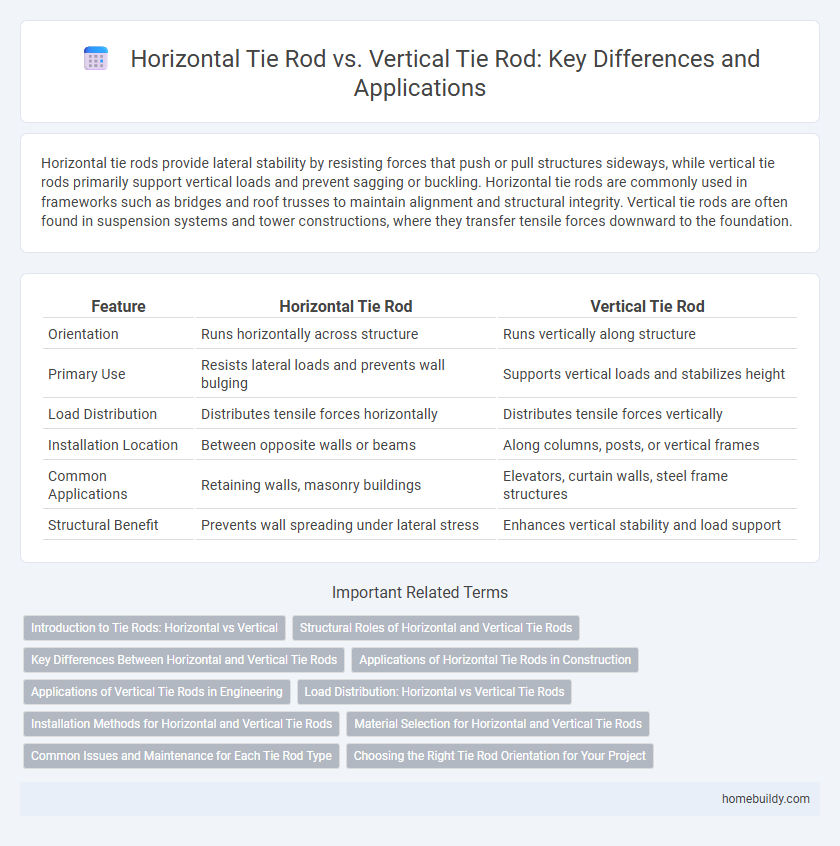Horizontal tie rods provide lateral stability by resisting forces that push or pull structures sideways, while vertical tie rods primarily support vertical loads and prevent sagging or buckling. Horizontal tie rods are commonly used in frameworks such as bridges and roof trusses to maintain alignment and structural integrity. Vertical tie rods are often found in suspension systems and tower constructions, where they transfer tensile forces downward to the foundation.
Table of Comparison
| Feature | Horizontal Tie Rod | Vertical Tie Rod |
|---|---|---|
| Orientation | Runs horizontally across structure | Runs vertically along structure |
| Primary Use | Resists lateral loads and prevents wall bulging | Supports vertical loads and stabilizes height |
| Load Distribution | Distributes tensile forces horizontally | Distributes tensile forces vertically |
| Installation Location | Between opposite walls or beams | Along columns, posts, or vertical frames |
| Common Applications | Retaining walls, masonry buildings | Elevators, curtain walls, steel frame structures |
| Structural Benefit | Prevents wall spreading under lateral stress | Enhances vertical stability and load support |
Introduction to Tie Rods: Horizontal vs Vertical
Horizontal tie rods provide lateral support by connecting opposite structural elements, preventing sideways movement and enhancing stability in frameworks such as bridges and buildings. Vertical tie rods, in contrast, primarily manage tensile forces by connecting vertical components, ensuring load distribution and structural integrity in frameworks like trusses and towers. Understanding the distinct roles of horizontal and vertical tie rods is crucial for optimizing design strategies in various engineering applications.
Structural Roles of Horizontal and Vertical Tie Rods
Horizontal tie rods primarily provide lateral stability and resist forces that cause walls or frames to bulge outward, ensuring structural alignment under horizontal loads. Vertical tie rods contribute to supporting vertical loads and help in distributing tensile forces evenly along columns or walls, preventing buckling and enhancing overall load-bearing capacity. Together, these tie rods optimize the structural integrity by counteracting multi-directional stresses in buildings and bridges.
Key Differences Between Horizontal and Vertical Tie Rods
Horizontal tie rods primarily provide lateral stability by resisting horizontal forces and preventing side-to-side movement, whereas vertical tie rods focus on bearing vertical loads and supporting structural weight. Horizontal tie rods are commonly used in frameworks subject to wind or seismic pressure, while vertical tie rods are essential in columns and truss systems for load transfer. Material strength, placement orientation, and load direction are critical factors distinguishing the two types of tie rods in construction and engineering applications.
Applications of Horizontal Tie Rods in Construction
Horizontal tie rods are commonly used in construction to provide lateral support and stabilize walls, beams, and framework during building erection. They effectively distribute tension forces across horizontal spans, preventing structural deformation and ensuring alignment in retaining walls and masonry structures. Horizontal tie rods are essential in scaffolding systems and bridge construction, where maintaining consistent horizontal integrity is critical for safety and load distribution.
Applications of Vertical Tie Rods in Engineering
Vertical tie rods are primarily used in engineering applications to provide tensile support and stability in structures such as bridges, towers, and cranes. Their vertical alignment efficiently transfers loads, resists bending moments, and maintains structural integrity under dynamic and static forces. Commonly found in tension systems of suspension bridges and high-rise buildings, vertical tie rods enhance load distribution and prevent buckling.
Load Distribution: Horizontal vs Vertical Tie Rods
Horizontal tie rods distribute tensile loads evenly across a structural element, reducing lateral displacement and enhancing stability in frameworks like bridges and trusses. Vertical tie rods primarily bear axial loads, transferring forces directly downward to support points, which is crucial in tower structures and vertical load-bearing walls. Understanding these load distribution mechanisms optimizes structural integrity and prevents deformation under varying stress conditions.
Installation Methods for Horizontal and Vertical Tie Rods
Horizontal tie rods are typically installed by affixing them parallel to the ground, often anchored through walls or frames using heavy-duty bolts and brackets to resist lateral forces effectively. Vertical tie rods require installation by fastening them vertically between floor and ceiling structures, commonly utilizing turnbuckles or threaded rods for adjustable tension and load distribution. Both methods demand precise alignment and secure anchoring to maintain structural integrity and prevent deformation under stress.
Material Selection for Horizontal and Vertical Tie Rods
Material selection for horizontal tie rods typically prioritizes high tensile strength and corrosion resistance, with carbon steel and stainless steel being common choices to withstand lateral loads and environmental exposure. Vertical tie rods require materials that optimize compressive strength and durability, often using galvanized steel or alloy steel to resist buckling and ensure long-term stability under vertical stress. Both orientations demand careful consideration of mechanical properties and environmental factors to maintain structural integrity and safety.
Common Issues and Maintenance for Each Tie Rod Type
Horizontal tie rods frequently experience wear due to lateral stress and misalignment, leading to issues such as uneven tire wear and steering instability, necessitating regular inspection and lubrication. Vertical tie rods, exposed to more vertical load and vibration, often suffer from faster joint degradation and corrosion, requiring frequent tightening and replacement of worn components to maintain proper alignment. Routine maintenance for both types includes checking for bend or damage, ensuring secure mounting, and timely replacement to prevent steering failure.
Choosing the Right Tie Rod Orientation for Your Project
Selecting the appropriate tie rod orientation depends on load direction and structural requirements, with horizontal tie rods best for resisting lateral forces and vertical tie rods ideal for supporting vertical loads. Horizontal tie rods are commonly used in bracing walls and frames to prevent lateral movement, while vertical tie rods provide tension support in columns and trusses. Consider material strength, installation environment, and project-specific stress points to optimize durability and performance.
horizontal tie rod vs vertical tie rod Infographic

 homebuildy.com
homebuildy.com